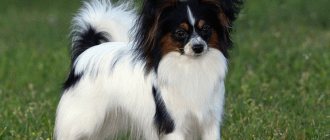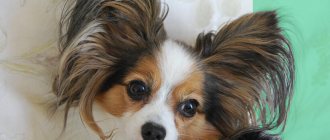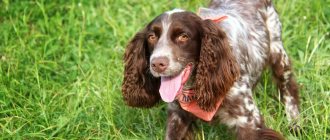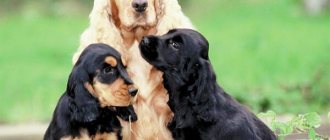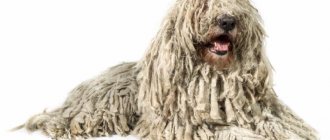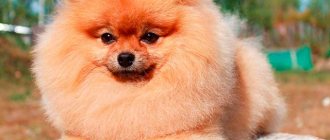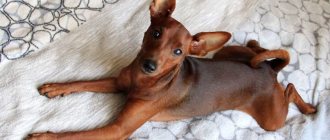The Papillon is a small, beautiful dog with a recognizable appearance. Because of its widely spaced ears, covered with long, hanging hair, the breed was called the “butterfly”. Papillons are cheerful, sociable and intelligent. This is not just a lap dog that will lie on the sofa, but an ideal companion that strives to follow its owner everywhere. This is one of the most popular decorative breeds. But before getting a Papillon, you need to study the description of these dogs, their characteristics, pros and cons, and reviews from owners.
- Head
- Features of education
- Health
Breed traits
Breed traits (on a 5-point scale)
| Papillon | |||
| Activity | in the house | 1.8 | |
| on the street | 2.7 | ||
| Obedience | training | 4.5 | |
| strangers | 3 | ||
| Domination | in family | 1.5 | |
| over dogs | 1 | ||
| Defending your territory | from people | 1 | |
| from dogs | 1 | ||
| Sociability | in family | 5 | |
| with strangers | 3 | ||
| with dogs | 3 | ||
| Concentration | in family | 1 | |
| in front of strangers | 3 | ||
| with dogs | 2 | ||
| Aggressiveness | in family | 2.5 | |
| to strangers | 3.8 | ||
| to the dogs | 3 | ||
| to cats | 2 | ||
| Family behavior | calmness | 4.8 | |
| demand for affection | 5 | ||
| excitability | 2.6 | ||
| playfulness | 3 | ||
| excessive barking | 2 | ||
| behavioral breakdowns | 1.8 | ||
| Tolerance for children | up to 4 years | 4.7 | |
| over 4 years old | 4.8 | ||
| Institutional use | watchman | 1.2 | |
| bodyguard | 1 | ||
This breed is often compared to the following dog breeds: Pomeranian, Chihuahua, Cavalier King Charles Spaniel, Yorkshire Terrier, Jack Russell Terrier.
The photo shows what a Papillon dog looks like:
Photo and video review
Before choosing a pet, you should look at the photos of these cute creatures, after which there will be no doubt about buying such a dog. You can clearly see the behavior and features of caring for the Pipillon in the video.
The Papillon breed is an excellent choice for both beginning breeders and more experienced trainers. The appearance of the dogs will not leave anyone indifferent; children love them very much, and their pets reciprocate their feelings. But when grooming, you should pay attention to the fur and claws. The key to health is proper nutrition, daily walks, active games and love from the owners.
General characteristics of the Papillon breed
The Papillon is a small toy breed of dog whose beautiful ears resemble butterfly wings. They are widely spaced and covered with long hair. This is why the breed received its name, since papillon is translated from French as “butterfly”. Experts call her a continental toy spaniel, and amateurs call her a “daddy.” Less popular is another variety of the breed - Phalene - with hanging ears.
Papillons love their owners very much, they are loyal and affectionate. They need attention and care and are very sensitive. This is a cheerful and good-natured companion, but always ready to bravely rush to protect his family members. The Papillon is smart, curious and active. Capable of learning tricks, suitable for agility. The breed ranks 8th in the ranking of the smartest dogs.
| Options | Characteristic |
| breed name | continental toy spaniel, papillon or papillon |
| country of origin | France |
| group of breeds according to the ICF classification | decorative dogs |
| height | 20-28 cm |
| weight | 3-5 kg |
| life expectancy | 13-15 years old |
| purpose | companion |
| peculiarities | smart, sociable, active, cheerful |
| aggressiveness | sometimes aggressive, may bite |
| activity | high |
| intelligence | very smart, easy to train |
| attitude towards a person | friendly, loyal, do not tolerate loneliness well |
| care | complex grooming |
| health | good |
pros
The Papillon is a small dog with an attractive appearance and a sociable, cheerful character. It is popular among lovers of decorative breeds and ranks first in intelligence. This is explained by many advantages:
- very smart, quick-witted;
- inquisitive, loves to learn new things, can learn different tricks;
- loyal, accompanies the owner everywhere;
- kind and affectionate;
- easily adaptable, you can take it with you on a trip;
- friendly, loves to play with children;
- cheerful, cheerful;
- does not spoil furniture, does not chew things;
- gets along easily with other pets, except rodents;
- clean, no dog smell.
Minuses
Most of the shortcomings of these dogs are the same as those of other breeds of a similar size. This is a fragile physique, a ringing voice and the possibility of aggression. Papillons also have other disadvantages:
- very active, energetic, love to run;
- you need to carefully select your diet, otherwise you will gain weight;
- may bite painfully;
- requires careful grooming;
- In winter they need clothing and get cold quickly.
This interesting video explains in more detail the pros and cons of the Papillon breed:
Video: Papillon pros and cons of the breed
Rules for choosing a puppy
There are no special criteria by which breeders can choose a puppy. Many people focus on appearance, choosing a furry cat or a baby with a cute face. If you plan to take your pet to exhibitions and competitions, then you need to approach the choice more responsibly, focusing on important criteria:
- proportional relationship of the head with other parts of the body;
- it is preferable that the puppy’s parents take prizes in professional competitions;
- compliance with international standards;
- correct structure of the limbs and tail;
- normal psycho-emotional state, absence of excessive aggression and nervousness.
The Papillon can be a reliable guard, but when choosing, you need to analyze his temperament. Restrained and even somewhat cold individuals are suitable for these purposes. From such a toddler you can raise a brave defender. Each breeder chooses the pros and cons of a butterfly dog independently.
History of the origin of the Papillon breed
Continental Toy Spaniels have been known in France since the 14th century. They were popular among the nobility. These small beautiful dogs were taken to receptions and balls. Due to their unique attractive appearance and good-natured nature, Papillons were loved by many French kings. That’s what they were called back then – “the lap dog of kings.” These pets can be found in paintings by famous artists.
Only at the end of the 19th century did the breed appear in America, and at the beginning of the 20th century did British breeders become interested in it. These dogs began to be crossed with Spitz dogs, as a result of which modern Papillons have a fluffier coat.
The breed was officially recognized in the 20s of the 20th century and was called the continental toy spaniel. American cynologists divide it into two varieties: the Papillon with erect ears and the Phalene with hanging ears. In Europe, these two breeds are considered separate and their crossing is not allowed. The French standard was adopted in 1934, since then the requirements for the appearance of dogs have remained almost unchanged.
Description of the appearance of representatives of the Papillon breed
The main feature of the Papillon's appearance is its graceful ears, covered with long, hanging hair. Because of them, the contours of the dog resemble a butterfly. Outwardly, she looks like a plush toy: thick shiny fur, an elegant face with a charming smile, sparkling intelligent eyes. Sometimes the breed is confused with Spitz or Chihuahua, although they have nothing in common. This is a miniature spaniel. The Papillon's height is 20-28 cm, weight is from 2.5 to 5 kg.
Head
The head is proportional to the body, elongated. The muzzle is sharp, slightly pointed, the stop is pronounced. The bridge of the nose is straight, medium-sized, well pigmented. The teeth are sharp and strong. Lips are dry, teeth and tongue are not visible. The eyes are large, but not protruding, almond-shaped. They are dark in color and set low. The look is lively and attentive.
The ears are thin, large, triangular in shape, erect. They are widely spaced, the tips are rounded and directed to the sides. On the outer edge there is long, soft hair hanging down in a fringe. Because of this, the Papillon's head is contoured like a butterfly.
The phalen variety has ears set high and drooping. That's why these dogs were called so: phalène in French moth. All continental toy spaniel puppies are born with floppy ears; differences between breeds are noticeable only by 4 months.
Body type
The physique is graceful. The neck is of medium length, the scruff is pronounced. The back is straight, the lower back is convex. The chest is wide, the stomach is tucked.
The tail is set high and covered with long hair. The dog lifts it up and bends the tip. He can only lightly touch the back, but does not lie on it and does not curl into a ring.
Limbs
The limbs are thin and smooth. The elbows are pressed to the body, the joints are weakly defined. The paws are elongated, the toes are strong, and there is long hair between them. The dog's movements are smooth and graceful.
Coat and color
The coat is shiny, wavy and long. In some places it reaches a length of 15 cm. On the head and the front surface of the paws it is short and smooth. There are featherings on the ears, tail, pants and collar. There is almost no undercoat.
According to the standard, the Papillon can have any color except blue. The main thing is that white color dominates the body. Usually the spots are black or red. Three-color color possible. White markings may be present on the head.
Photos complement the description of the appearance:
Character of Papillons
In addition to their attractive appearance, these dogs are famous for their amazing character. They almost never have a bad mood, they are always cheerful and active. They are interested in everything, they love to learn new things. This is a companion who is ready to accompany the owner and help him in any matter. They are not capricious, they calmly endure any travel and trips.
Papillons only do not tolerate rudeness and disrespect. They have a soft character, so even a rude shout can cause them to become depressed. These pets require attention and affection, they are very sociable, but not intrusive. You can’t pamper them, they are a very smart dog, they will quickly find a person’s weaknesses and begin to take advantage of them.
These dogs are calm with children and patient. They readily support any games and make the child happy. They get along well with cats and other decorative breeds of dogs. But since the toy spaniel is still a hunting breed, it is better not to leave them alone with rodents or birds.
Despite their small size, these dogs can be good watchdogs. Although they are usually friendly towards people, they do not like noise or large groups. With their ringing bark they attract the attention of the owner, and if necessary, they fearlessly rush to defense.
The Papillon is characterized by the following character traits:
- friendliness;
- cheerfulness;
- curiosity;
- intelligence;
- sensitivity;
- devotion;
- sociability;
- responsiveness;
- playfulness;
- devotion;
- determination;
- emotionality;
- touchiness.
The photo complements the characteristics of these dogs:
Features of education
Papillons are smart and easily learn new commands and skills. These dogs are used in agility, freestyle and other sports. They are capable of performing even the most difficult tricks. These dogs understand many words and, thanks to their curiosity, love to learn.
Despite their gentle nature, Papillons require timely socialization and proper upbringing. Without this, they can become aggressive and even bite. The puppy needs to be shown how to behave, and unwanted behavior must be stopped immediately. Education must be consistent and regular. All family members must comply with the same requirements.
Training a Papillon is not difficult, but it is important to structure the lessons in the form of a game. These dogs are often distracted, this also needs to be taken into account and try to interest the pet. Commands are given in a calm, firm voice. Don't yell at or hit your dog. Papillons do not like rough treatment. It is better to use the reward method with affection and treats. By six months, the puppy should have learned the basic commands:
- place;
- to me;
- it is forbidden;
- ugh;
- stand;
- near;
- sit.
The pet must be taught not to beg for food or to pick up anything on the street. It must respond adequately to cars and street noise, to strangers and animals. Conveniently, in dangerous situations on the street you can take your pet in your arms. It is advisable not to allow your dog to sleep on the bed.
You shouldn't spoil your Papillon. Some owners treat decorative pets like toys. But the Papillon is very smart and power-hungry. He will immediately sense the weakness in the owner’s behavior and will take advantage of it. In this case, the pet may become uncontrollable, capricious and playful.
Video about the peculiarities of raising a Papillon:
Video: Meet the Papillon.
Positive traits
The breed has such advantages as:
- Appearance;
- Intelligence;
- Friendliness;
- Cleanliness;
- Devotion.
The Papillon is a beautiful breed. Often an animal is adopted because of its appearance. Butterfly ears and a fluffy tail are the main decorations of the individuals. The smooth, contrasting coat attracts the attention of others.
Dogs are smart and capable of learning. At an early age, training goes without problems. The little puppy immediately gets used to the nickname and quickly gets accustomed to commands. An adult animal is more difficult to train, so the owner must immediately begin training the puppy.
They are distinguished by their friendly character. Get along with other pets. It is even recommended to get an animal other than rodents together with the Papillon - the dog will hunt them. This way the dog won’t get bored in the absence of its owner. They get along with children. A child for a pet will become the best companion for joint games. Treats children's pranks patiently and does not show aggression.
Owners often praise the cleanliness of these dogs. The dog easily learns to relieve himself in the litter tray. Doesn't need walks every day. In bad weather, you don’t have to walk your pet; the Papillon is squeamish about dirty puddles.
Thoroughbred individuals are distinguished by their devotion to the entire family. The attention of loved ones is important to them; they cannot stand loneliness. They quickly adapt to their surroundings and are ready to follow their owner everywhere.
Content Features
Papillons easily adapt to life in an apartment of any size or in a private house. Such dogs are not kept outside, especially in the cold season. Due to the lack of undercoat, they freeze, so in winter it is recommended to wear clothes for walks. Despite their size, these dogs are active, so they need to be walked twice a day for at least half an hour.
At home, the Papillon needs to be given a place to sleep. The bed or house is placed away from drafts and heating appliances. It is advisable that the pet can see the room from its place and be able to observe the owner. Toys are required so that the Papillon does not get bored. This dog can be diaper trained to use the toilet in the house. But this does not exclude the need for daily walks.
Caring for a Papillon is almost the same as caring for other decorative breeds. Only the condition of the coat needs to be taken seriously. It quickly becomes tangled and tangles form. Therefore, it is recommended to comb it 2 times a week, and daily during shedding. Before the procedure, the hair must be sprayed with water, or better yet, with conditioner. This will prevent brittleness and discomfort in the dog.
It is recommended to trim the hair between the toes, on the belly and in the groin, this will make it easier to maintain cleanliness. In summer, you can shorten the hair on the body a little. Bathing very often is not recommended, it is harmful to the skin. Papillons are clean and do not get very dirty outside. Usually it is enough to wash their paws after going outside, and wash them completely once a month. It is better to use a special shampoo for long-haired dogs. You need to dry your pet with a hairdryer after washing, otherwise the fur will become tangled.
The following hygiene procedures will also be required:
- examine your eyes every day and wipe with a cotton pad soaked in chamomile decoction;
- ears are cleaned of dust and dirt several times a week;
- if the claws do not grind down naturally, they should be trimmed as needed;
- To prevent the formation of tartar, you need to brush your teeth every week with veterinary paste.
The video will help you understand how to care for these dogs:
Video: Features of the content of “Papillon”.
Video: Grooming a Papillon puppy
Video: Papillons: all about the breed, features of care and character
Health
Papillons have fairly good health. With proper care, they live 13-15 years, and some individuals even live up to 18 years. Until old age they remain active and cheerful. There are few hereditary diseases in the breed. Usually these are eye diseases, congenital deafness, joint injuries. To prevent infectious and parasitic diseases, you need to regularly treat your pet for fleas and worms and carry out timely vaccinations.
Nutrition
The owner immediately needs to find out from the veterinarian what is best to feed the Papillon. This can be natural food or dry food. It is not recommended to overfeed, these dogs are prone to weight gain. An adult dog needs to be fed twice a day. With any method of nutrition, it is forbidden to give food from your table, sweets, smoked meats, or baked goods.
With a natural diet, the bulk of the diet should be lean meat. Pork, minced meat and chicken are not recommended. You can give offal, cereals, vegetables, herbs, and dairy products. It is recommended to add calcium and vitamins to food. This could be chalk, seaweed, bone meal or fish oil.
If the owner decides to feed the pet dry food, you need to choose super-premium or holistic class options. They should be grain-free, preferably not chicken-based, as representatives of this breed often have allergies.
Rules of education and training
The puppy needs time to learn the rules of behavior in the house and learn commands. It is unreasonable to, say, schedule weekly classes over the weekend, trying to cram the entire educational course into the puppy's mind in hours of intensive training.
Training is done every day, but without overtiring the animal - the dog becomes capricious from overload, can forget what it has learned and, in its own way, will be right in refusing to learn.
Dog handlers combine the “dry” theory of training with play - this way the dog is keenly interested in what is happening and understands everything perfectly.
They start with the minimum. After 2-3 weeks, the puppy remembers the allocated personal place - with a bed, toys, and a bowl. Masters the toilet (puppies wear a diaper at home, they are accustomed to outdoor activities from 2-3 months). Boundaries are outlined for the pet (climbing onto the sofa is allowed, but not on the table or bed). The dog is not allowed to carry and chew the owner's things. They teach you a nickname.
https://dog-care.ru/porody/reyting/papilon-otzyvy-vladeltsev.html
In parallel with education, basic commands are studied:
- "To me". It is practiced when the pet is called for a significant reason - to walk, feed, play, comb out its fur. An uninterested dog will begin to react to words - running up, looking into the eyes expectantly, running away about the dog's business. It will take time to teach her to run up when she hears a command and freeze next to her.
- "Near". Initially, it is studied by walking the pet on a leash. With an obedient dog, in the absence of temptations to run away nearby, they begin to practice unfastening the leash.
- "Ugh". Studied to protect pets from picking up debris from the ground. It is wise to save it for walks, and to stop pranks at home, the prohibitory, easily comprehended command “No” will help.
- "Give". A universal team that adds variety to games with your pet and facilitates its training in individual training courses. The command is practiced with the pet's toys, then with some of the owner's things.
The young dog begins to practice unfamiliar commands at home. After waiting for the commands to be learned, the lessons are repeated in an urban environment - a street, a park, a dog park.
Having turned walks in the fresh air into a puppy's daily routine, he is gradually taught the rules:
- Walk a step away from the owner’s feet, waiting for permission to move away and play;
- Don’t be stubborn about returning home and washing your paws;
- Do not show aggression or obsessive friendliness towards domestic or wild animals;
- Refuse to approach strangers, even those luring you with delicious food.
A pet's education should never be a "mush." It is impossible to simultaneously try to teach him to fetch a ball, walk next to him, or dance funny on his paws in one day. Only when he has mastered one thing can he move on to another.
One of the rules of training is this: the dog’s owner must be a fair friend and leader. Leading dog handlers agree that physical punishment should not be applied to a dog, it destroys its psyche. Disobedience usually occurs due to a person’s inability to establish contact and build relationships. Psychological violence towards a pet is unacceptable, which includes screaming, rudeness in the voice, punishment by ignoring for mistakes. Moderate severity is permitted - but only as a last resort.
And then the owner’s dissatisfaction will become the saddest thing in the world for the dog, which it will try to avoid by all available means.
It is worth mentioning possible incentives:
- Praise in a gentle tone;
- The treat is delicious;
- Affectionate touches.
Training is done by playing with the dog, which has released its pent-up energy and has had its fill of fun.
Often training failures occur due to the inability to attract the dog’s attention, to show it that everything that is happening is serious. She already communicates with the owner every day, but for some reason she must be imbued with the importance of the moment. In education and training, objects that attract attention are used - whistles, rattles.
How to buy a Papillon puppy
It is recommended to buy puppies from a nursery. In Moscow, a purebred Papillon costs 30-50 thousand rubles. Show class puppies will cost more – from 70 thousand. You can buy a dog cheaper from private breeders, but there is no guarantee that it will not be a mixed breed or without genetic diseases.
When purchasing, you need to study all the documents, there must be a veterinary passport. It is recommended to have your puppy's hearing tested, as representatives of this breed often have congenital deafness. A healthy baby is cheerful and curious. The coat is shiny, the belly is soft, the eyes and ears are clean. He should not be cowardly or lethargic.
The photo shows what the puppies look like:
Before getting a dog of this breed, you need to watch another video about it:
Video: Everything about the breed. Papillon. Butterfly.
Video: Meeting pets: Papillon dogs
Video: Papillon dog butterfly.
Video: Papillon - All about the dog breed
The Papillon is a small dog that can become a good friend and companion. She is loyal and affectionate, loves to be the center of attention. The popularity of the breed is explained by its attractive appearance and cheerful character. This pet is suitable for families with children, elderly people, and those who live in a small apartment. But despite its small size, it is a rather active and sociable dog. You shouldn't get such a pet if you don't have time to care for it.
Papillon dog: health and illness
Papillon
The Papillon dog is in great demand among film directors, artists and is a favorite of society ladies. The dog is called a “butterfly” because of its erect ears, reminiscent of the fluttering wings of a butterfly. Papillons are considered the most unpretentious and healthy among the dwarf breeds. Distinctive feature of animals:
- Characterized by excellent immunity
- Strong nervous system
- Live on average to 18-20 years
The causes of dog illnesses are usually caused by improper care, unbalanced nutrition and late vaccination. Here are the diseases that can appear in representatives of this breed.
Eyes:
- In a healthy pet, they should be clean and wide open.
- If your dog has tear tracks, it is necessary to determine the cause.
- If a foreign body enters, eliminate the irritant and monitor the condition of the eyes.
- Sometimes the cause of tearfulness can be improperly selected food, usually oversaturated with protein and carbohydrates. One of the symptoms may be inversion of the eyelids or eyelashes; immediate elimination of the cause is necessary, otherwise the inflammation of the lacrimal sac will continue and lead to more serious consequences.
- Genetic causes are also possible, unfortunately, then the pet is incurable and, as a consequence, retinal atrophy. The result is complete loss of vision.
Brittle bones:
- They cause all kinds of injuries and fractures.
- Most often, the dog suffers from the kneecap, which is prone to displacement when running. Symptoms of this disease: changes in the shape of the hind limbs, lameness, knee pain. If both joints are damaged, the pet constantly squats due to pain.
- You should not self-medicate; you need to contact a veterinarian in time.
- You may need surgery, and in mild cases, supportive, fortified therapy.
- A timely visit to the clinic guarantees the dog’s recovery. If the disease is genetic, then there is a possibility of complications and relapses.
For hearing problems:
- The pet constantly scratches its ears and rubs them until they bleed, and a dark coating appears inside.
- The cause may be ear mites. Symptoms: foul odor, discharge, swelling of the ear. It is necessary to use anti-mite ear drops and undergo a course of treatment with antibacterial drugs. Delayed treatment can result in hearing loss.
- Deafness can be either acquired or congenital.
- Deafness cannot be cured, but it can be prevented by paying attention to the first symptoms and following the rules of caring for the animal.
Low sugar:
- Symptoms of hypoglycemia: unsteadiness when walking, exhaustion and cramps. You urgently need to give the dog something sweet.
- Low blood sugar can be caused by an unbalanced diet, incorrectly selected food for the puppy, stress, or if the animal is constantly freezing.
Unusual sneezing:
- The symptom is convulsive inhalation of air and hoarseness.
- The cause is caused by dust, pollen, and grains of sand entering the nasal cavity.
- Symptoms may go away on their own, but if the sneezing continues, you should contact your veterinarian.
The owner must clearly remember that the Papillon needs timely care. The disease cannot be left to chance. Failure to provide timely assistance can lead, at best, to surgery, and at worst, to death.


